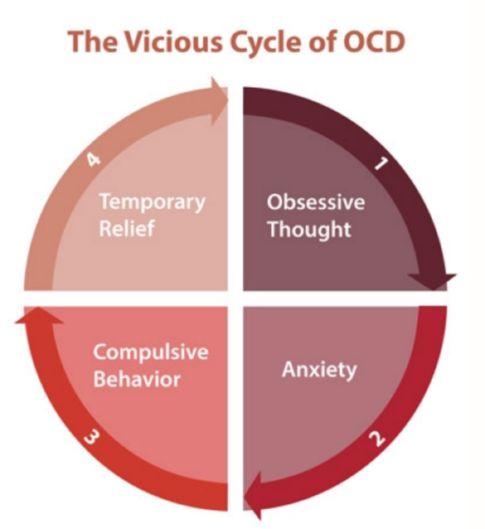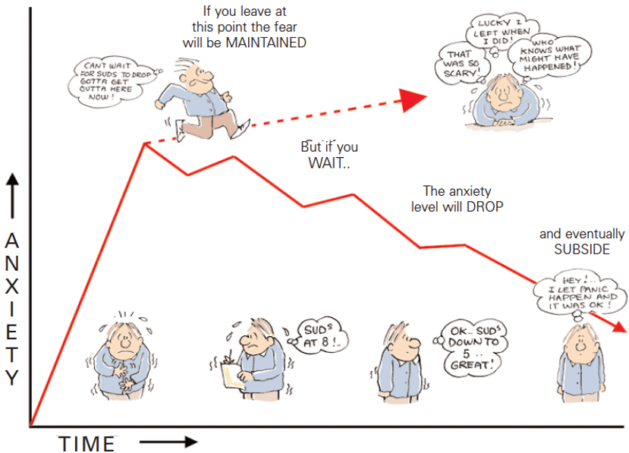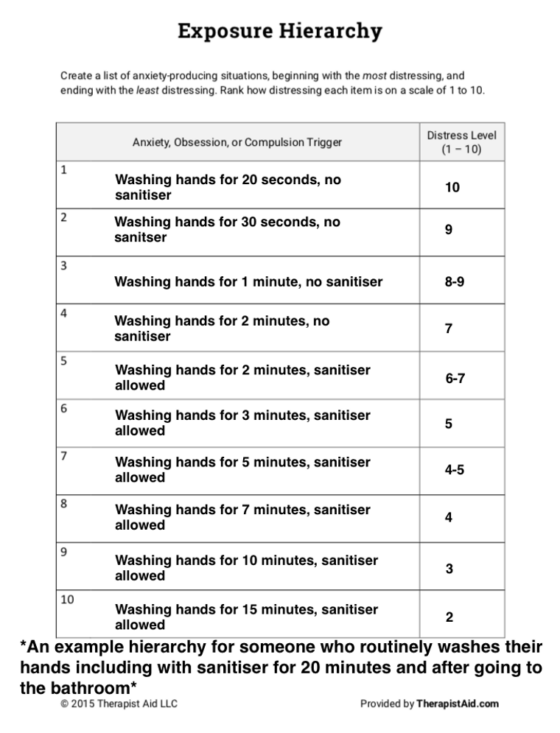Treating Obsessive-Compulsive Disorder
laura on 08/05/2023

Image source: helpguide.org
What is Obsessive-Compulsive Disorder (OCD)?
Maybe you’ve heard someone refer to themselves as having “OCD” or being “OCD” about certain things like cleanliness or orderliness. In reality, OCD is a mental illness that can dramatically impact someone’s life. OCD is characterised by the presence of intrusive and unwanted thoughts, ideas or images (obsessions) that lead to increased anxiety and repetitive, intentional rituals (compulsions) that are used to remove the anxiety. For more information relating to the understanding of OCD, check out our earlier blog here: https://yourmindmatters.net.au/understanding-obsessive-compulsive-disorder-ocd/
Why does OCD occur?
OCD tends to gradually build in severity due to the relationship that exists between the two factors, obsessions and compulsions. We are hardwired to attempt to solve problems with behavioural solutions, which for a long time in history that was integral! Thousands of years ago, we needed to effectively identify and avoid threats. If we didn’t feel the need to run away from a tiger hurdling towards us, we probably wouldn’t survive very long. In OCD, there is a miscalculation of a threat, where our obsessive, intrusive thought causes us undue anxiety. Often, we’re aware that these obsessions are irrational, yet we still have an urge to escape the “threat”. For example, someone with OCD may find themselves frequently thinking “If I forgot to turn the stove off, my house will burn down!” (obsession) feeling more and more anxious about it until they check to confirm they indeed have turned the stove off (compulsion). By checking, they have addressed the anxiety and the worry goes away until the obsession returns, which in some cases may be in a matter of minutes. In OCD, the person’s brain has LEARNT that the COMPULSION relieves ANXIETY and therefore wants to do it more!
How is OCD treated?
OCD can be a challenging condition to treat. Prolonged practice of challenging obsessions and confronting compulsions can assist in minimising the severity of OCD and can significantly improve wellbeing. When dealing with OCD, we want to focus on addressing both Obsessions and Compulsions, if we can find ways to disrupt both elements, we have two points of attack in challenging the OCD cycle.
Cognitive Behavioural Therapy (CBT) is a first-line recommended treatment for OCD. In CBT, we attempt to understand why the obsessions are occurring and why our brain has labelled them as “threatening”. During this process we also explore strategies that help us to minimise the use of compulsions, which are often the most impactful element of OCD. Often, this is done through something called exposure therapy.
Graded Exposure and Response Prevention Therapy for OCD
When entering a cold body of water, you might find it uncomfortable or difficult to stay in the water. However, after some time submerged, your body becomes used to the cold sensation and the water becomes much easier to tolerate. Much like cold water, the longer we can sit in the discomfort of anxiety without using compulsions to escape (i.e., get out of the water), the easier it gradually becomes.
(Image source: CBT4Panic.org)
Graded Exposure and Response Prevention Therapy (ERP) is a process frequently used in addressing the compulsions of OCD. In this process, the client and the therapist work together to develop an exposure hierarchy, which is like a ladder of different experiences that are gradually more anxiety-provoking. After this, the client is exposed to each level of the ladder over a handful of sessions until each level feels manageable, gradually reaching the top of the ladder. In each instance, the job is to sit in the anxiety without using the compulsion to “escape” (or get out of the pool).
It’s a bit like weightlifting! If we want to lift 100kg and we’ve never touched a weight, it’s going to be very hard because we aren’t strong enough. But if we gradually increase the weight as we build up our strength, eventually we can lift the 100kg! The best thing about this process is that the task in front of us isn’t getting any harder because we are getting stronger. Similarly, our exposure hierarchy doesn’t tend to get much harder because we are building our tolerance to different situations.
ERP is super helpful in addressing compulsions but also facilitates challenging our anxious obsessions. Our anxious voice tells us that we have to use our compulsions in these situations, which we are able to challenge by showing ourselves that we can get through the discomfort without them.
(Example exposure hierarchy source: TherapistAid.com)
If you would like assistance addressing personal challenges in your own life related to OCD, why not give us a call? Our team of highly skilled and well-experienced Psychologists are here to help. Call us now and take that first step towards obtaining the life you deserve!
References
Abramowitz, J. S., Deacon, B. J., & Whiteside, S. P. H. (2010). Exposure therapy for anxiety : Principles and practice. ProQuest Ebook Central https://ebookcentral.proquest.com
Abramowitz, J. S. (2006). The psychological treatment of obsessive—compulsive disorder. The Canadian Journal of Psychiatry, 51(7), 407-416. doi: 10.1177/070674370605100702.
Hezel, D. M., & Simpson, H. B. (2019). Exposure and response prevention for obsessive- compulsive disorder: A review and new directions. Indian Journal of Psychiatry, 61(1), S85. doi:10.4103/psychiatry.IndianJPsychiatry_516_18
This blog was written by Steven Andritsos – Psychologist at YMM.
Steven recently completed the Master of Clinical Psychology program at Charles Sturt University. He is passionate about collaboratively working with clients and using research-backed interventions to assist treatment plans.
Steven is interested in working with teenagers and adults who may be experiencing challenges related to depression, anxiety, sleep disturbances, phobias, and other sources of daily stress. With a primary foundation of cognitive behavioural therapy (CBT), Steven explores the integration of other therapeutic techniques (including Dialectical Behaviour Therapy, Mindfulness, and Acceptance and Commitment Therapy) in order to optimise the cooperative work he does with his clients.
To learn more about Steven, check out the “Our Team” page on our website! https://yourmindmatters.net.au/our-team/
- Category: Anxiety management


